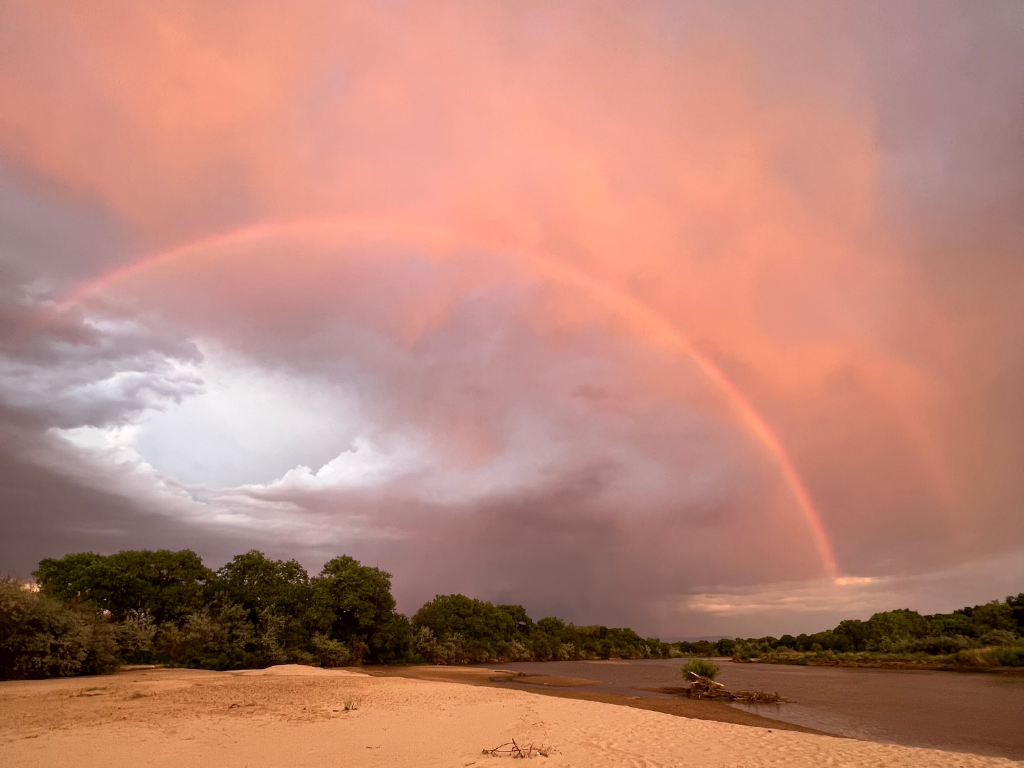In the desert, every drop counts.
Right now, the Rio Grande is suffering. Water managers at the Middle Rio Grande Conservancy District (MRGCD) announced that the Rio Grande will run dry in Albuquerque for the second time in forty years. In mid-August, MRGCD warned that a drying event was possible following July’s record-breaking temperatures and lack of seasonal monsoon rains. Now, a dry Rio is only a matter of time.
The story of water in New Mexico is complex. Approximately 40% of MRGCD’s irrigation supply comes from the San Juan-Chama Project, which utilizes a system of diversion dams, channels and other infrastructure to siphon water out of the Colorado Basin and send it to the Rio Grande. The remaining 60% of the water supply comes from natural flows in the Rio Grande watershed.
Despite a winter of heavy snow followed by abundant spring runoff, on July 17 MRGCD began releasing water from the San Juan-Chama Project to meet higher-than-normal irrigation demands in the face of lower than expected natural summer flows. These supplemental releases began a month earlier than MRGCD anticipated, and the irrigation district ran out of San Juan-Chama Project water before the end of August.

Rio Grande near Albuquerque, Joanna Zhang photo
Without water, the Rio Grande wilts. Since mid-August, approximately 30 miles of the San Acacia Reach and about 4 miles of the Isleta Reach of the Rio Grande have been nothing but a dry, sandy riverbed. For a river that used to run year-round, this drying has catastrophic consequences on the local ecosystem as well as human communities. A trickle of water continues to make its way through the Albuquerque reach, but it won’t last long with minimal rain, no supplemental water to rely on and irrigation channels continuing to pull from what little water the river has left.
Though we pay more attention to the disaster that is the Rio Grande drying through Albuquerque, we’ve grown accustomed to an annual pattern of the Rio Grande drying just south of the city. The Rio Grande used to flow year-round, but it doesn’t even make headlines anymore when less well-known stretches of the river dry up. As the river is about to dry through Albuquerque for the second year in a row, we can’t be complacent and allow this terrible reality to become the new normal. Simply praying for rain isn’t enough.
Currently, agriculture uses three-quarters of the water in the Rio Grande. As a result, the river has been dammed and channelized so much that its natural processes have been disrupted. Year after year, we see the Rio Grande become a patchwork of disconnected stretches of water that can no longer migrate across its floodplain. The roaring spring floods that once distributed cottonwood tree seeds and created backwater habitat for silvery minnow are no more.

Rio Grande, dry, July 2023, photo Daniel Timmons
It’s hard to overstate how much the Rio Grande matters. The Rio Grande provides water for urban use, Tribal and non-Tribal farmers, and recreators. This vital river supports fish and wildlife including imperiled species like the critically endangered Rio Grande silvery minnow. The dire water crisis facing the Rio Grande won’t be resolved by pitting one water user group against another. Rather, it’s a matter of managing the Rio Grande in a way that balances the needs of all who depend on its water and accounts for the impacts of climate change such as aridification and increased average temperatures.
As the river dries up through Albuquerque yet again, we must face the consequences of the Rio Grande no longer being a living river. We must bring it back to life. We’re calling on water managers to change the way they’ve been treating the Rio Grande. It’s time we stop taking advantage of the Rio Grande like it’s a sewage system, and start cherishing it like a living river. We must restore the Rio Grande’s natural flows as best we can and give the river the legal protections it needs to survive and support the countless communities of life it upholds.
